[OPINION] Marketing in the
The recent Covid-19 outbreak is going to change many things in our world, but one thing is for...
15 May 2020
Social media consumption has drastically changed during the first three months of 2020. In this article we take a look at those changes, along with the impact and opportunities this will have on brands, post covid.
During the first few months of 2020 amid the global crisis, both global and local social media consumption changed drastically and this has had unprecedented effects on companies and consumers alike. However, not all of these changes have been negative, and as we head into “post-covid”, a term coined for the new normal after the global pandemic, we take a look at how these changes have presented new opportunities for brands.
“The Interactive Advertising Bureau says that one in four media buyers and brands have paused all advertising for the first half of 2020, while Facebook has reported that 89% of advertisers have taken action with their budgets in response to COVID-19 - "with 45% saying they have adjusted media type usage or shifted budget among media types".
Additionally, people are still expecting to hear from brands. According to a recent Kantar study , 92% of people surveyed thought businesses should continue to advertise during the COVID-19 outbreak.
As stated by the Interactive Advertising Bureau, businesses have been faced with a unique set of challenges and many have been left wondering how to successfully navigate their social media marketing within this changing climate and have been carefully considering their online marketing efforts.
Being passionate about social media and being part of a data-driven company like Spitfire Inbound, I conducted some research into what these changes are and how they have affected companies in South Africa, and more importantly, what opportunities these changes present going forward.
According to the latest data from We Are Social, we can see that the global spike in social media usage per country has surged in recent weeks. This is by far the clearest trend we’ve seen during the global crisis.
As social isolation continues, people turn to social media to stay connected, and the report states that, “Almost half of internet users (47 percent) in surveyed countries say they’ve been spending longer using social media, while roughly half of these users (23 percent) say they’ve been spending “significantly” more time using social media compared to their pre-lockdown behaviours.”
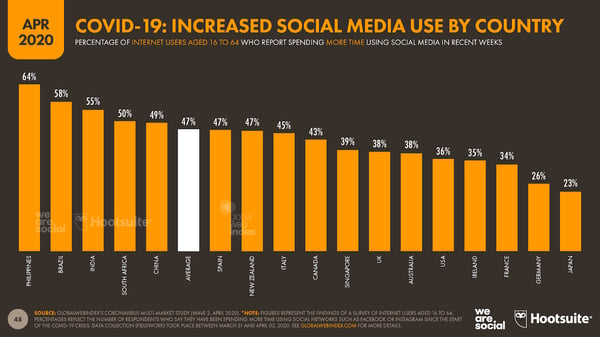
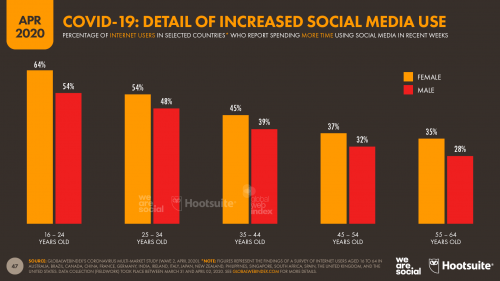
According to social media monitoring tool Brands24, the below infographic shows a global snapshot of social media consumption and sentiment around the keyword “covid-19” within the last 30 days (24th March - 24th April).
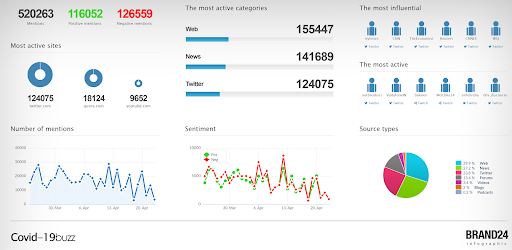
In the below two graphs, we can see the sentiment around the keyword “covid-19”, as well as the number of mentions and the social media reach (Twitter specific). Again, these graphs are based on the last 30 days (24th March - 24th April 2020).
-2.png?width=1600&name=pasted%20image%200%20(3)-2.png)

Interestingly, when we take a closer look at sentiment around the keyword “covid-19”, South Africa has a more positive than negative sentiment, as compared to the previous graph, which shows the total global sentiment is more negative.
Reaching out to my network of fellow social media marketers, surprisingly, the insights and results were all fairly consistent. I posed the following questions - and here are the results:
Yes, most South African brands have changed their social media marketing, with the majority of them stopping their paid social media spend all together. There has been some change in organic content, with brands either slightly reducing the amount of content being published or not reducing it at all, but rather changing the messaging in a bid to stay visible and keep their online brand awareness up.
The major changes to organic content have been in the retail and hospitality sectors. Some of the brands within these industries have opted to reduce or stop publishing content (organic and paid) altogether during the global crisis as a direct result of their offline businesses being completely shut during the national lockdown.
There seems to be a shift towards helpful and educational content, with less focus on the brands themselves. The overwhelming consensus is that South African brands’ messaging has definitely changed, moving from aggressive advertising to a softer approach, with a strong focus on educating online audiences on the effects of the pandemic and precautionary steps to take to flatten the curve, as well as how to stay safe both in public and at home. Most brands are wanting to help their audiences as much as they can during the global crisis.
The below graph from GlobalWebIndex indicates, “Tutorials and how-to videos are amongst the top kinds of content that consumers want more of during the COVID-19 crisis, and these may represent a particularly compelling opportunity for B2B brands”.
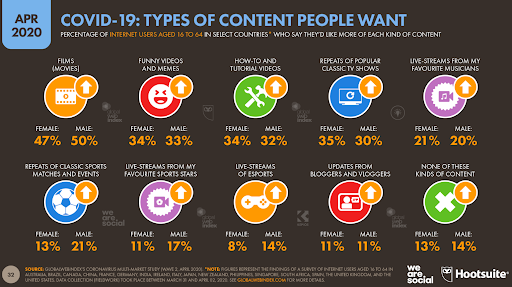
Social media consumption has drastically increased since January 2020. While follower growth has slowed down significantly, the biggest changes have been an increase in user consumption, brand awareness and user engagement.
We can assume this is because the majority of users are at home, and likely to be spending more time online. Engagement metrics such as shares and retweets have significantly increased, however, conversions have significantly decreased.
Audiences are seemingly interested in attaining information about how the global crisis may affect brands’ services and products, as well as any policy relief plans from cover-specific products in industries such as insurance and medical services.
On a global level, Facebook recently published a report that stated, “The COVID-19 outbreak is also impacting digital and device behaviour. Mobile phone data usage in the US increased over 50% in March, compared to 2019. And in the US and UK, Gen Z, Gex X, and Boomers all say they’re spending more time checking social media due to concerns around COVID-19 (27%, 29% and 15% more, respectively)”. This corroborates the above research done on a local scale.
Along with that, each of the major social media platforms has experienced changing trends and consumption patterns. Let’s take a deeper look.
As the global social media power-house, Facebook has seen massive changes in recent weeks, with many people across the globe turning to Facebook and Instagram to stay connected with friends, family, and their wider communities.
In response to this, Facebook has released various reports, guides and resources to help marketers make better, more informed decisions when it comes to their social media marketing and paid spend. They have placed emphasis on strategies around how brands can continue to market to their audiences, in a more authentic way, leveraging Facebook and Instagram’s platform functionality, such as live streaming, stories and cross-platform posting.
It’s also important to note that Facebook Messenger and WhatsApp (which is owned by Facebook) have seen a massive uptick in user consumption. Mark Zuckerberg recently told journalists that these platforms have seen twice the usual number of calls, with WhatsApp seeing a 40% increase in user consumption since most European countries went into lockdown earlier this year.
Compared to January 2020, an additional 76 million people saw adverts on Facebook in March 2020 compared to December 2019 as seen in the below graph sourced from the GlobalWebIndex report. It is estimated that advertisers can now reach up to 2 billion people on Facebook and Instagram.
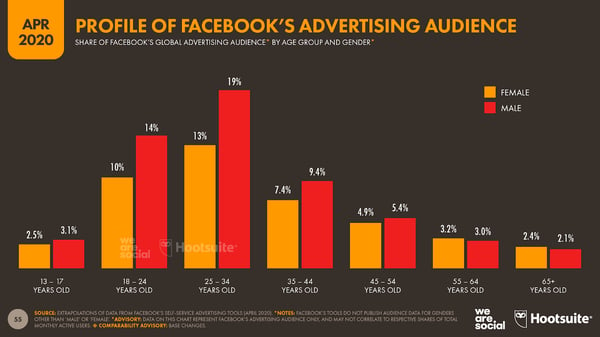
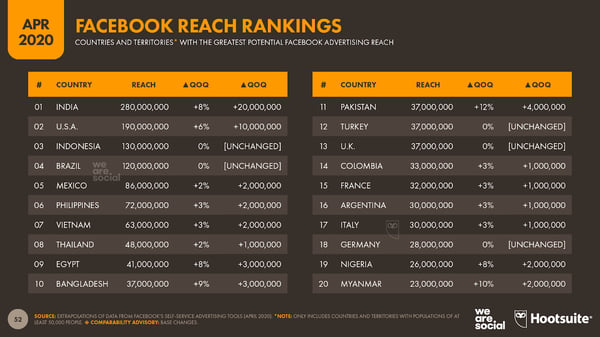
The same report from GlobalWebIndex also states that, “Twitter saw the biggest quarterly jump amongst the top social media platforms. Numbers published in the company’s self-service advertising tools show that advertisers can now reach 47 million more people on Twitter compared to January 2020, equating to a quarter-on-quarter increase of 14%.”
It’s clear that Twitter has become the go-to source for real-time news updates, with journalists being the most active source of publishing content, as seen below in a report from Tweetbinder.com, which shows local South African data from the last 30 days, specifically focusing on the keyword “covid19SA” (24th March - 24th April).
.png?width=512&name=unnamed%20(1).png)
What is also incredibly interesting to note, is that in a report from Brands24, South Africa is one of the top 10 countries in terms of active mentions around the same keyword and time frame.
-1.png?width=512&name=unnamed%20(2)-1.png)
LinkedIn has seen a 55% increase in engagement between connections, in recent weeks, while it's also seeing more content posted, messaging volume has also increased. Searches for “remote working” are up 3x in recent weeks.
-1.png?width=512&name=unnamed%20(3)-1.png)
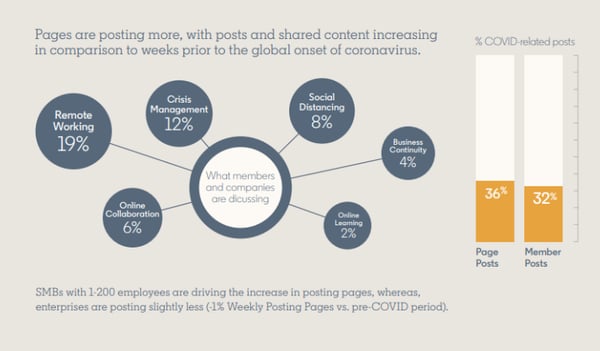
Not surprisingly, YouTube channel traffic is up 15%. The majority of that interest is focused on COVID-19 news and updates. This makes sense because people are spending more time online as a way to stay connected with the outside world, as they currently have no other outlet.
Although TikTok is incredibly tight-lipped on the consumption increase trends at the moment, a report recently released by App Annie stated that both TikTok and SnapChat have seen significant increases in the amount of time people are spending on the platforms, while Reddit has reported that it has seen increases of 20-50% in traffic to subreddits related to business, finance, news, education, travel, and sports.
Unlike the rest of the social media platforms, Pinterest has taken a very different view on things. Basically, they are blocking any “covid-19 or “coronavirus” keyword searches. When users are searching for “coronavirus” or “covid-19” they are sent to a sparse page with content from the World Health Organisation.
To expand on that, Pinterest said it does not allow ads “that are looking to profit from this health crisis, such as those price gouging or encouraging stockpiling.”
Interestingly, now is the time to advertise on social media, especially for SMEs. Big enterprise businesses will have to readjust their budgets and will probably have to spend more when they do start advertising again, to reach the same levels as they did, pre global crisis.
Competition is low, and social media usage is at an all-time high, meaning marketers will get “more bang for their buck” - your adverts and campaigns have the opportunity for greater reach and brand awareness, performing better than they may have done historically.
Along with this, we recommend that brands practise an “always on approach” to their organic social media marketing. This will ensure visibility at the top of the funnel, especially while the larger enterprise businesses are not spending large amounts of their advertising budget right now.
Additionally, brands could be encouraged to think creatively about their messaging, for example, giving users the chance to purchase vouchers for when they are back to their normal day-to-day operations, or leveraging the #supportlocal initiatives that are trending at the moment.
-2.png?width=600&name=pasted%20image%200%20(4)-2.png)
While the surge in social media consumption presents opportunities for brands going forward, it is still advisable to practise some cautionary measures. As these are unprecedented times, there is no “one size fits all” when it comes to brands leveraging these online trends.
Right now, brands have to be agile in their approach to social media marketing - anything can happen, post covid.
Subscribe to our blog and get all our exciting content delivered to you either weekly or monthly or check out our resources page for helpful downloads.
With thanks to the following people for contributing to my research:
Jessica Rose McEndoo - Social Path
Karen Peterson - Network Explosion
Maricelle Gouws - The Cheese Has Moved
Taurayi Pswarayi - Vetro Media
The recent Covid-19 outbreak is going to change many things in our world, but one thing is for...
Google search has come a long way over the past decade, and the search giant’s latest update ushers...
You can’t afford to ignore the changes happening around you in a world where artificial...
It’s hard to deny that technology will change the way you market, reality is we are headed for the...
Be the first to know about new B2B SaaS Marketing insights to build or refine your marketing function with the tools and knowledge of today’s industry.